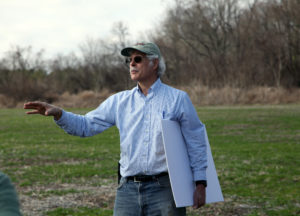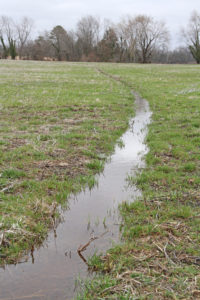
Skip Hyberg, Senior Economist, USDA Farm Service Agency, stands in front of an edge of field conservation practice on Maryland’s Eastern Shore. Photo by Julie Polt, USDA Farm Service Agency
By Skip Hyberg, Senior Economist, USDA Farm Service Agency
“As of 2015, an estimated 18,091,710 people lived in the Chesapeake Bay watershed, up from 17,986,898 in 2014. Experts predict the watershed’s population will surpass 20 million by 2030 and reach 21.4 million by 2040. Each of the 18.1 million people that live in the region affects the Bay: consuming resources, altering the landscape and polluting the air and water.” — Chesapeake Bay Program
The Chesapeake Bay watershed, North America’s largest estuary, is huge. It includes parts of six states from New York to Virginia, the entire District of Columbia, and drains 64,000 square miles of land. The bay and surrounding area is home to a complex, intricate food web and a large population of wildlife. Various pollution sources cause stress on this system.
Recently, a diverse team from USDA, Maryland DNR, Penn State University, and other organizations traveled to the Eastern Shore of Maryland to view and discuss conservation practices intended to slow or stop drainage of pollutants into rivers and streams that feed the bay. USDA conservation programs, such as the Conservation Reserve Enhancement Program (CREP), administered by the Farm Service Agency, are a primary means for improving water quality in ecosystems by encouraging landowners to adopt effective conservation practices. Edge of field conservation practices, such as grass and forest buffers, slow the flow of water thereby reducing the movement of pollutants like nitrogen and phosphates, common in fertilizer, from the farmlands to the streams.
More needs to be done and more is being done. Through the Maryland Chesapeake Bay CREP, federal and state resources are made available to voluntarily enroll in the USDA Conservation Reserve Program (CRP) for 10-year to 15-year contracts. Participants remove cropland and marginal pastureland from agricultural production and convert the land to native grasses, trees and other vegetation or restore wetlands. This improves water quality by reducing soil runoff, increasing water infiltration and reducing stream sedimentation and nutrient loading from pastures and agricultural fields. CREP also enhances and restores plant and wildlife habitat.
According to estimates from the USDA Natural Resources Conservation Service (NRCS), there are more than 83,000 farm operations in the watershed, and they produce commodities ranging from corn and soybeans, chickens and cattle, to fruit and vegetables. These farms are an important economic engine, but according to estimates from the Chesapeake Bay Program, agriculture contributes 42 percent of the nitrogen, 55 percent of the phosphorous and 60 percent of the sediment entering the Bay.

Jody Kenworthy, Farm Programs Assistant, Maryland State Office, Farm Service Agency and Justin Fritscher, USDA National Office, on the bank of a tree-lined pond that collects spring runoff. (USDA photo by Janet Connelly, FSA)
Slowing down water flow is a good thing. The more we can slow down the flow, the better, because it gives grass, trees and other natural buffer materials more time to consume pollutants and neutralize them. During our visit to the Eastern Shore, we viewed a number of the 3,000 forest buffers that have been planted to hold soil and moderate water runoff in the state. We also saw how trees, grass, and strategically placed wetlands slow the movement of water and pollutants from fields to streams.
Dr. Anne Hairston-Strang, forest hydrologist with the Maryland Department of Natural Resources Forest; and Timothy Culbreth, Chesapeake Watershed Forester, have documented the preliminary results from a study of the impacts of buffers over a 15-year period. Their analysis shows levels of phosphate, which travels through surface water, are substantially reduced, “The vegetation of the buffers are doing a good job of reducing erosion and slowing water down as it travels toward streams.”The report also notes changes in nitrate levels can be substantial even though that pollutant is delivered primarily through ground water.
Farmers, ranchers, USDA, Maryland, and conservationists are joining together to undertake a long-term team effort. Through the establishment of conservation techniques including buffers we are helping to reverse decades of decline in water quality and ecosystem diversity in the Chesapeake watershed.

Seasonal runoff is slowed by edge of field conservation practices. (USDA photo by Janet Connelly, FSA)





